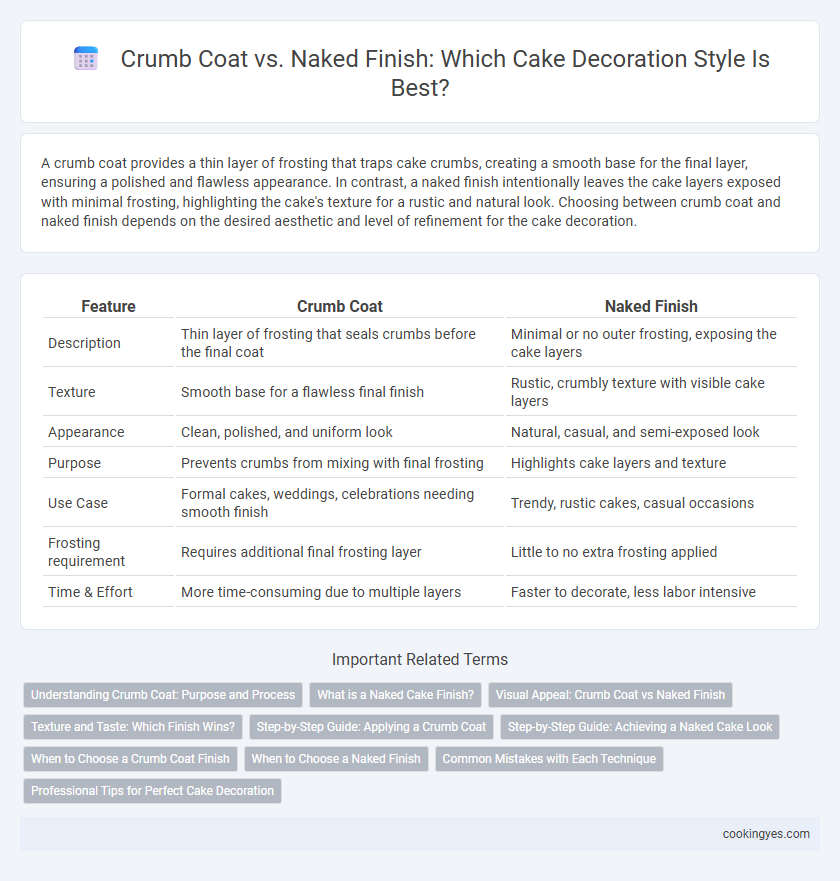A crumb coat provides a thin layer of frosting that traps cake crumbs, creating a smooth base for the final layer, ensuring a polished and flawless appearance. In contrast, a naked finish intentionally leaves the cake layers exposed with minimal frosting, highlighting the cake's texture for a rustic and natural look. Choosing between crumb coat and naked finish depends on the desired aesthetic and level of refinement for the cake decoration.
Table of Comparison
| Feature | Crumb Coat | Naked Finish |
|---|---|---|
| Description | Thin layer of frosting that seals crumbs before the final coat | Minimal or no outer frosting, exposing the cake layers |
| Texture | Smooth base for a flawless final finish | Rustic, crumbly texture with visible cake layers |
| Appearance | Clean, polished, and uniform look | Natural, casual, and semi-exposed look |
| Purpose | Prevents crumbs from mixing with final frosting | Highlights cake layers and texture |
| Use Case | Formal cakes, weddings, celebrations needing smooth finish | Trendy, rustic cakes, casual occasions |
| Frosting requirement | Requires additional final frosting layer | Little to no extra frosting applied |
| Time & Effort | More time-consuming due to multiple layers | Faster to decorate, less labor intensive |
Understanding Crumb Coat: Purpose and Process
A crumb coat is a thin layer of frosting applied to a cake to seal in crumbs and create a smooth surface for the final layer of decoration. This process ensures that the outer icing remains clean and free of unwanted crumbs, enhancing the cake's overall appearance and texture. Proper application of the crumb coat is essential for achieving a polished finish, especially when using fondant or intricate decorations.
What is a Naked Cake Finish?
A naked cake finish features minimal to no outer layer of frosting, allowing the cake layers and filling to be visible. This style highlights the natural texture and color of the cake, often with a thin crumb coat applied to prevent crumbs from mixing with the filling. Popular for rustic or minimalist designs, naked cakes emphasize simplicity and fresh ingredients over heavy decoration.
Visual Appeal: Crumb Coat vs Naked Finish
A crumb coat provides a smooth, polished base that enhances the cake's visual appeal by creating a clean, flawless surface for additional decoration. In contrast, a naked finish exposes the cake layers and filling, offering a rustic, natural look that highlights texture and color contrasts. Choosing between crumb coat and naked finish depends on whether a sleek elegance or artisanal charm best suits the cake's overall aesthetic.
Texture and Taste: Which Finish Wins?
Crumb coat provides a smooth, even texture that seals in cake crumbs while enhancing the moist, rich taste of buttercream or ganache layers. Naked finish exposes the cake's crumb and natural texture, offering a lighter, less sweet experience ideal for showcasing artisanal flavors and fresh ingredients. Texture-wise, crumb coat delivers a polished bite, whereas naked finish emphasizes the cake's authentic crumb structure and natural moisture.
Step-by-Step Guide: Applying a Crumb Coat
Applying a crumb coat involves spreading a thin layer of frosting over the cake to trap loose crumbs and create a smooth base for the final layer. Begin by chilling the cake to firm up the surface, then use an offset spatula to apply the frosting evenly, ensuring all sides are covered. Once the crumb coat is applied, refrigerate the cake for 15-30 minutes to set before adding the final decorative layer or opting for a naked finish.
Step-by-Step Guide: Achieving a Naked Cake Look
Start by applying a thin crumb coat of buttercream to seal in cake crumbs and create a smooth surface. Chill the cake for 15-30 minutes to set the crumb coat before applying a thin, uneven layer of frosting to emphasize the cake's natural texture. Use a bench scraper held at a slight angle to gently remove excess frosting, revealing the cake layers beneath for the signature naked cake appearance.
When to Choose a Crumb Coat Finish
A crumb coat is essential when working with delicate or layered cakes to seal in loose crumbs and provide a smooth base for the final layer of frosting. Choose a crumb coat finish to ensure a polished, even surface that supports detailed decorations or fondant application. This technique prevents crumb contamination and enhances the overall appearance of intricately designed cakes.
When to Choose a Naked Finish
A naked finish is ideal when showcasing the natural texture and colors of the cake layers is desired, such as in rustic or minimalist designs. It works best for moist cakes like sponge or carrot that hold shape without heavy frosting, offering a light, less-sweet dessert option. Home bakers select naked finishes to highlight fresh fruit or floral decorations, emphasizing organic aesthetics over smooth, frosted surfaces.
Common Mistakes with Each Technique
Common mistakes in applying a crumb coat include using too thick a layer, which can lead to an uneven surface and difficulty in smoothing the final frosting. For a naked finish, errors often involve insufficiently chilling the cake before scraping, causing frosting to slide off and exposing unintended cake crumbs. Both techniques require precise timing and temperature control to achieve smooth, visually appealing results.
Professional Tips for Perfect Cake Decoration
A crumb coat is a thin layer of frosting applied to lock in crumbs, ensuring a smooth and clean final layer, essential for professional cake decoration. Choosing a naked finish highlights the cake's texture and layers, creating a rustic yet elegant presentation favored in contemporary baking. Mastery of crumb coat application prevents crumb contamination, while skillful naked finish execution showcases artistic cake design without excess frosting.
Crumb Coat vs Naked Finish for cake decoration Infographic

 cookingyes.com
cookingyes.com